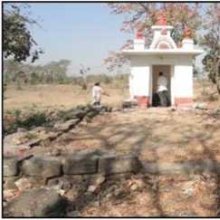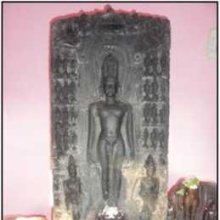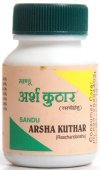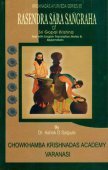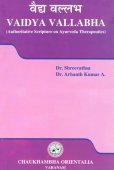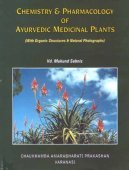Arshas, Arśa, Arsa, Arsha, Ārṣa, Arśas, Ārśa, Arṣa, Arsā: 37 definitions
Introduction:
Arshas means something in Hinduism, Sanskrit, Marathi, Hindi, biology. If you want to know the exact meaning, history, etymology or English translation of this term then check out the descriptions on this page. Add your comment or reference to a book if you want to contribute to this summary article.
The Sanskrit terms Arśa and Ārṣa and Arśas and Ārśa and Arṣa can be transliterated into English as Arsa or Arsha or Arsas or Arshas, using the IAST transliteration scheme (?).
Images (photo gallery)
In Hinduism
Ayurveda (science of life)
Kalpa (Formulas, Drug prescriptions and other Medicinal preparations)
Source: Shodhganga: Edition translation and critical study of yogasarasamgrahaArśa (अर्श) refers to “piles” and is one of the various diseases mentioned in the 15th-century Yogasārasaṅgraha (Yogasara-saṅgraha) by Vāsudeva: an unpublished Keralite work representing an Ayurvedic compendium of medicinal recipes. The Yogasārasaṃgraha [mentioning arśa] deals with entire recipes in the route of administration, and thus deals with the knowledge of pharmacy (bhaiṣajya-kalpanā) which is a branch of pharmacology (dravyaguṇa).
Rasashastra (Alchemy and Herbo-Mineral preparations)
Source: Wisdom Library: Rasa-śāstraArśas (अर्शस्) or Arśoroga refers to “piles” according to the fourth volume of the Rasajalanidhi (chapter 5). Accordingly, “the main indication of the disease [i.e., arśas-roga] is the growth of lumps of flesh, either outside or inside the rectum. Piles may lead to the growth of all sorts of diseases. Bleeding piles are those which are due to an abnormal excess of pitta. Those which grow isolated from one another, and give rise to udavarta, are due to abnormal excess of vayu. Those, due to an abnormal excess of kapha, are accompanied with swelling. Piles, due to an abnormal excess of all the three doshas, have all those symptoms combined”
Unclassified Ayurveda definitions
Source: Wisdom Library: Āyurveda and botanyArśa (अर्श) is a Sanskrit technical term, translating to “hemorrhoids”. The term is used throughout Ayurvedic literature such as the Suśruta-saṃhitā and the Caraka-saṃhitā.
Source: archive.org: Vagbhata’s Ashtanga Hridaya Samhita (first 5 chapters)Arśas (अर्शस्) refers to “hemorrhoids”, as mentioned in verse 5.13-14, 25 of the Aṣṭāṅgahṛdayasaṃhitā (Sūtrasthāna) by Vāgbhaṭa.—Accordingly, “[...] as concerns (water from) wells, ponds, etc., one should know (if it comes) from jungle, swamp, or rock. No water or, in case of incapability, little (is) to be drunk by those suffering from weak digestion and visceral induration (and) by those suffering from jaundice, abdominal swellings, diarrhea, hemorrhoids [viz., arśas], dysentery, and cutaneous swellings. Except in autumn and summer, even a healthy man shall drink only little”.
Source: archive.org: Science And Technology In Medievel India (Ayurveda)Arśa (अर्श) refers to “piles” and is one of the various diseases dealt with in the Dhanvantarīyapathyāpathya, as is mentioned in A. Rahman’s Science and Technology in Medievel India: A bibliography of source materials in Sanskrit, Arabic and Persian.—Ancient and medieval India produced a wide range of scientific manuscripts and major contributions lie in the field of medicine, astronomy and mathematics, besides covering encyclopedic glossaries and technical dictionaries.—The Dhanvantarīyapathyāpathya deals with the treatment of various diseases [e.g., Arśa]. The word pathyāpathya classifies those elements as either beneficial or hurtful in disease.
Source: Research Gate: Internal applications of Vatsanabha (Aconitum ferox wall)Arśa (अर्श) refers to “piles” (Haemorrhoids: swellings containing enlarged blood vessels found inside or around the rectum and anus). Medicinal formulations in the management of this condition include 13 references of Vatsanābha usages. Cūrṇa is maximum (7) dosage form in the management of Arśa. Vatsanābha (Aconitum ferox), although categorized as sthāvara-viṣa (vegetable poisons), has been extensively used in ayurvedic pharmacopoeia.
Source: Ancient Science of Life: Vaidyavallabha: An Authoritative Work on Ayurveda TherapeuticsArśas (अर्शस्) or Harṣa refers to “haemorrhoids”, and is dealt with in the 17th-century Vaidyavallabha written by Hastiruci.—The Vaidyavallabha is a work which deals with the treatment and useful for all 8 branches of Ayurveda. The text Vaidyavallabha has been designed based on the need (viz., arśas) of the period of the author, availability of drugs during that time, disease manifesting in that era, socio-economical-cultural-familial-spiritual-aspects of that period Vaidyavallabha.
In chapter 5, Bhallātaka (Semecarpus anacardium) is mentioned as the main drug for the disease arśas (Haemorrhoids).
Source: gurumukhi.ru: Ayurveda glossary of termsArśa (अर्श):—Piles or polypus

Āyurveda (आयुर्वेद, ayurveda) is a branch of Indian science dealing with medicine, herbalism, taxology, anatomy, surgery, alchemy and related topics. Traditional practice of Āyurveda in ancient India dates back to at least the first millenium BC. Literature is commonly written in Sanskrit using various poetic metres.
Purana and Itihasa (epic history)
Source: archive.org: Puranic EncyclopediaĀrṣa (आर्ष).—A form of marriage. Brāhma is the form of marriage in which the bride is given to a man of good ancestry and fine character. Marriage by giving the bride after receiving a pair of cows from the bridegroom is called Ārṣa. Prājāpatya is the form of marriage in which the bride is given to the man who asks for her. When the bride is given with dowry, the marriage is known as Āsuram. Marriage with the mutual love and consent is Gāndharva. Capturing the bride after a fight and marrying her by force is Rākṣasa. Marriage after deceiving the bride is called Paiśāca. These are the seven types of marriage. According to the author of the Smṛti another form of marriage known as DAIVA is also mentioned. (Agni Purāṇa, Chapter 154).
Source: Cologne Digital Sanskrit Dictionaries: The Purana Index1a) Ārṣa (आर्ष).—A form of marriage; girls to be given in the Ganges-Yamuna doab.*
- * Matsya-purāṇa 106. 8; Viṣṇu-purāṇa III. 10. 24.
1b) Origin of; when the whole world was in a state of cetana-acetana knowledge like the fish in the water, the truth influenced by cetana arises with guṇa; kārya is the result of kāraṇa or reason; so also viṣaya is the result of viṣayitva and artha of arthitva; by this mahat and others function by degrees.*
- * Vāyu-purāṇa 59. 63-8.

The Purana (पुराण, purāṇas) refers to Sanskrit literature preserving ancient India’s vast cultural history, including historical legends, religious ceremonies, various arts and sciences. The eighteen mahapuranas total over 400,000 shlokas (metrical couplets) and date to at least several centuries BCE.
Vyakarana (Sanskrit grammar)
Source: Wikisource: A dictionary of Sanskrit grammarĀrṣa (आर्ष).—Derived from the holy sages; founded on sacred tradition, such as the Vedāṅgas;cf. कृत्स्नं च वेदाड्गमनिन्द्यमार्षम् (kṛtsnaṃ ca vedāḍgamanindyamārṣam) R. Prāt. XIV 30. The word is explained as स्वयंपाठ (svayaṃpāṭha) by the com. on Vāj Prāt. IX.2I, and as Vaidika saṃdhi on X.l3. Patañjali has looked upon the pada-pāṭha or Pada-text of the Saṃhitās of the Vedas, as anārṣa, as contrasted with the Saṃhitā text which is ārṣa; cf. आर्ष्याम् (ārṣyām) in the sense संहितायाम् (saṃhitāyām) R. Prāt. II.27; cf. also पदकारैर्नाम लक्षणमनुवर्त्यम् (padakārairnāma lakṣaṇamanuvartyam) M.Bh. on III.1.109.

Vyakarana (व्याकरण, vyākaraṇa) refers to Sanskrit grammar and represents one of the six additional sciences (vedanga) to be studied along with the Vedas. Vyakarana concerns itself with the rules of Sanskrit grammar and linguistic analysis in order to establish the correct context of words and sentences.
Shilpashastra (iconography)
Source: Shodhganga: Vaisnava Agamas And Visnu ImagesĀrsa (आर्स) refers to “icons in places installed by Ṛṣis”, as defined in treatises such as the Pāñcarātra, Pādmasaṃhitā and Vaikhānasa-āgamas, extensively dealing with the technical features of temple art, iconography and architecture in Vaishnavism.—As far as the Jīrṇoddhāraṇa (renovation) metal icons are concerned, the Vaiṣṇava Āgamas lay special rules because the authors of the Āgamas obviously knew the value and re-usable condition of metals. [...] Some special rules are prescribed in the Vaiṣṇava Āgamas regarding the jīrṇoddhāraṇa of the metal icons installed in the places generally known as svayaṃvyakta (self-emanated), divya (installed by divinities), saiddha (installed by Siddhas) and ārsa (installed by Ṛṣis). In the renovation process, the permission to correct the characteristics (lakṣaṇa) of the icon is not admissible in these aforesaid places. The measurements and characteristics less or more, the same material is to be retained as it were. [...]

Shilpashastra (शिल्पशास्त्र, śilpaśāstra) represents the ancient Indian science (shastra) of creative arts (shilpa) such as sculpture, iconography and painting. Closely related to Vastushastra (architecture), they often share the same literature.
Kavya (poetry)
Source: OpenEdition books: Vividhatīrthakalpaḥ (Kāvya)Arśas (अर्शस्) in Sanskrit (or Arisa in Prakrit) refers to “hemorrhoids”, as is mentioned in the Vividhatīrthakalpa by Jinaprabhasūri (13th century A.D.): an ancient text devoted to various Jaina holy places (tīrthas).—Cf. Meulenbeld 1974 p. 619.

Kavya (काव्य, kavya) refers to Sanskrit poetry, a popular ancient Indian tradition of literature. There have been many Sanskrit poets over the ages, hailing from ancient India and beyond. This topic includes mahakavya, or ‘epic poetry’ and natya, or ‘dramatic poetry’.
Shaivism (Shaiva philosophy)
Source: SOAS University of London: Protective Rites in the Netra TantraArśas (अर्शस्) refers to “hemorrhoids”, according to the Netratantra of Kṣemarāja: a Śaiva text from the 9th century in which Śiva (Bhairava) teaches Pārvatī topics such as metaphysics, cosmology, and soteriology.—Accordingly, [verse 19.121-128, while describing the prevention of natural disasters]—“[...] [He performs the ritual when people are afflicted by] skin diseases, etc., fevers, untimely death or various sorts of pain, past faults or seizing spirits. Diseases from snake poison, etc., insect bites, etc., rheumatism, change in form, phlegm, hemorrhoids (arśas), eye diseases, skin diseases, etc., internal disease, and sickness caused by wounds, etc., by the thousands [can occur] if various sorts of evils touch the Maṇḍala, a defect arises from offense [occurs]. [...]”.

Shaiva (शैव, śaiva) or Shaivism (śaivism) represents a tradition of Hinduism worshiping Shiva as the supreme being. Closely related to Shaktism, Shaiva literature includes a range of scriptures, including Tantras, while the root of this tradition may be traced back to the ancient Vedas.
General definition (in Hinduism)
Source: Wisdom Library: HinduismArṣa (hemorrhoids) is a Sanskrit medical term used in Ayurveda.
Biology (plants and animals)
Source: Google Books: CRC World Dictionary (Regional names)Arsa in India is the name of a plant defined with Entada rheedei in various botanical sources. This page contains potential references in Ayurveda, modern medicine, and other folk traditions or local practices It has the synonym Adenanthera gogo Blanco (among others).
Example references for further research on medicinal uses or toxicity (see latin names for full list):
· Flora Jamaicensis (1759)
· Bulletin de la Société Botanique de France (1952)
· Journal of Botany, being a second series of the Botanical Miscellany (Hooker) (1841)
· Journal of Taiwan Museum (1985)
· Sylva Telluriana (1838)
· Flora of Jamaica (1920)
If you are looking for specific details regarding Arsa, for example side effects, diet and recipes, extract dosage, pregnancy safety, chemical composition, health benefits, have a look at these references.

This sections includes definitions from the five kingdoms of living things: Animals, Plants, Fungi, Protists and Monera. It will include both the official binomial nomenclature (scientific names usually in Latin) as well as regional spellings and variants.
Languages of India and abroad
Marathi-English dictionary
Source: DDSA: The Molesworth Marathi and English DictionaryArśa (अर्श).—n m S corruptly arṣa n Disease of the anus, but particularly Hæmorrhoids or piles.
--- OR ---
ārṣa (आर्ष).—m (Corr. from arśa S) Hæmorrhoids or piles.
--- OR ---
ārṣa (आर्ष).—a (S) Relating to ṛṣi, saintly. 2 Sacred, holy, having authority--writings, institutes, knowledge. 3 fig. Dull, heavy, unheeding, superlatively stupid; inflexible in a preconception or determination; stupidly obstinate. 4 Foolish, silly, grossly absurd--speech, an opinion &c. Ex. mājhē śabda ārṣa nirdhāra || pari tumhī prīti ṭhēvilī ||
Source: DDSA: The Aryabhusan school dictionary, Marathi-EnglishArśa (अर्श).—n m Disease of the anus, piles.
--- OR ---
ārṣa (आर्ष).—a Saintly; sacred; fig. Dull; Silly. m Piles.
Marathi is an Indo-European language having over 70 million native speakers people in (predominantly) Maharashtra India. Marathi, like many other Indo-Aryan languages, evolved from early forms of Prakrit, which itself is a subset of Sanskrit, one of the most ancient languages of the world.
Sanskrit dictionary
Source: DDSA: The practical Sanskrit-English dictionaryArśa (अर्श).—a. Bringing misfortune, sinful; indecent.
-rśaḥ 1 Damage, hurt.
2) = अर्शस् (arśas) q. v.
--- OR ---
Ārśa (आर्श).—a. Belonging to the antelope.
--- OR ---
Ārṣa (आर्ष).—a. (-rṣī f.) [ऋषेरिदं अण् (ṛṣeridaṃ aṇ)]
1) Used by a Ṛiṣi only, relating or belonging to sages, beneficial to sages; शमो दमस्तथा धैर्यं सत्यं शौचमथार्जवम् । यज्ञो धृतिश्च धर्मश्च नित्यमार्षो विधिः स्मृतः (śamo damastathā dhairyaṃ satyaṃ śaucamathārjavam | yajño dhṛtiśca dharmaśca nityamārṣo vidhiḥ smṛtaḥ) || Mahābhārata (Bombay) 12.12.17; archaic, Vedic (opp. laukika or classical); आर्षः प्रयोगः (ārṣaḥ prayogaḥ); संबुद्धौ शाकल्यस्येतावनार्ष (saṃbuddhau śākalyasyetāvanārṣa) P.I.1.16 Sk.; आर्षे धर्मः (ārṣe dharmaḥ) Manusmṛti 3.29; Y.1.59; आर्षः प्रत्ययः (ārṣaḥ pratyayaḥ) P.II.4.58.
2) Sacred, holy, divine, superhuman; आदिकाव्यमिदं चार्षं पुरा वाल्मीकिना कृतम् (ādikāvyamidaṃ cārṣaṃ purā vālmīkinā kṛtam) Rām.6.128.15; Uttararāmacarita 6.
-rṣaḥ A form of marriage derived form the Ṛiṣis; one of the eight forms of marriage in which the father of the bride receives one or two pairs of cows from the bridegroom; आदायार्षस्तु गोद्वयम् (ādāyārṣastu godvayam) Y.1.59; Manusmṛti 3.53,9.196; for the names of the 8 forms see उद्वाह (udvāha); आर्षोढा (ārṣoḍhā) a wife married according to this form.
-rṣā A class of Vedic metres.
-rṣam 1 The holy text, the Vedas; आर्षं धर्मोपदेशं च वेदशास्त्रा- विरोधिना (ārṣaṃ dharmopadeśaṃ ca vedaśāstrā- virodhinā) Manusmṛti 12.16.
2) Sacred descent.
3) Derivation (of a poem) from a Ṛiṣi author.
-ārṣadharam Name of a Sāman.
Source: DDSA: The practical Sanskrit-English dictionaryArśas (अर्शस्).—n. [ṛ-asun vyādhau śuṭ ca Uṇādi-sūtra 4.195] Piles; नाशयित्री बलासस्यार्शसऽउपचितामसि (nāśayitrī balāsasyārśasa'upacitāmasi) Vāj.12.97.
Source: Cologne Digital Sanskrit Dictionaries: Edgerton Buddhist Hybrid Sanskrit Dictionary
Ārṣa (आर्ष).—[, corruption for ārṣabha, adj., q.v.: Bodhisattvabhūmi 385.17; Gaṇḍavyūha 401.8.]
Source: Cologne Digital Sanskrit Dictionaries: Shabda-Sagara Sanskrit-English DictionaryArśa (अर्श).—n.
(-rśaṃ) Hœmorrhoids, piles. Also arśas.
--- OR ---
Ārṣa (आर्ष).—mfn.
(-rṣaḥ-rṣī-rṣaṃ) Relating or belonging to or derived from a Rishi. m.
(-rṣaḥ) A form of marriage, the father of the bride receiving one or two pair of kine from the bridegroom. n.
(-rṣaṃ) The Vedas. f.
(-rṣā) One of the orders of the metres of the Vedas. E. ṛṣi and aṇ aff.
Source: Cologne Digital Sanskrit Dictionaries: Shabda-Sagara Sanskrit-English DictionaryArśas (अर्शस्).—n.
(-rśaḥ) Hœmorrhoids, piles. E. ṛ to go, asun Unadi affix, and śuṭ inserted.
--- OR ---
Arsas (अर्सस्).—m.
(-rsaḥ) Hœmorrhoids. See arśas.
Source: Cologne Digital Sanskrit Dictionaries: Benfey Sanskrit-English DictionaryArśas (अर्शस्).—probably ṛṣ + as (with ś instead of ṣ), n. Hæmorrhoids.
Source: Cologne Digital Sanskrit Dictionaries: Benfey Sanskrit-English DictionaryĀrṣa (आर्ष).—i. e. ṛṣi + a, I. adj. f. ṣī. 1. Referring to the Ṛṣis. 2. Ordained by or practised by the Ṛṣis, [Mānavadharmaśāstra] 3, 21; 12, 106. Ii. m. A form of marriage, [Mānavadharmaśāstra] 3, 53. Iii. n. Holy lineage.
Source: Cologne Digital Sanskrit Dictionaries: Cappeller Sanskrit-English DictionaryArśas (अर्शस्).—[neuter] haemorrhoids.
Source: Cologne Digital Sanskrit Dictionaries: Cappeller Sanskrit-English DictionaryĀrṣa (आर्ष).—[feminine] ī belonging to or derived from the Ṛṣis, archaic. [masculine] (± vivāha) a cert. form of marriage. [neuter] holy text or Veda; sacred origin.
Source: Cologne Digital Sanskrit Dictionaries: Monier-Williams Sanskrit-English Dictionary1) Arśa (अर्श):—m. (√ṛś), ‘damage’ See anarśa-rāti, (for arśas) hemorrhoids, piles, [cf. Lexicographers, esp. such as amarasiṃha, halāyudha, hemacandra, etc.]
2) Ārśa (आर्श):—mfn. ([from] ṛśya), belonging to the antelope, [Atharva-veda iv, 4, 5.]
3) Ārṣa (आर्ष):—mf(ī)n. relating or belonging to or derived from Ṛṣis (id est. the poets of the Vedic and other old hymns), archaistic, [Mahābhārata; Rāmāyaṇa] etc.
4) m. a form of marriage derived from the Ṛṣis (the father of the bride receiving one or two pairs of kine from the bridegroom), [Āśvalāyana-gṛhya-sūtra i, 6, 4; Manu-smṛti iii, 21; Yājñavalkya i, 58] (cf. vivāha)
5) n. the speech of a Ṛṣi, the holy text, the Vedas, [Nirukta, by Yāska; Ṛgveda-prātiśākhya; Manu-smṛti]
6) sacred descent [commentator or commentary] on [Lāṭyāyana; Yājñavalkya]
7) the derivation (of a poem) from a Ṛṣi author.
Source: Cologne Digital Sanskrit Dictionaries: Monier-Williams Sanskrit-English DictionaryArśas (अर्शस्):—[from arśa] n. piles, hemorrhoids, [Vājasaneyi-saṃhitā xii, 97, etc.]
Source: Cologne Digital Sanskrit Dictionaries: Yates Sanskrit-English Dictionary1) Arśa (अर्श):—(śaṃ) 1. n. Hoemorrhoids.
2) Ārṣa (आर्ष):—(rṣaḥ) 1. m. A form of marriage. a. Belonging to a sage.
Source: Cologne Digital Sanskrit Dictionaries: Yates Sanskrit-English DictionaryArśas (अर्शस्):—(śaḥ) 1. n. Idem.
Source: DDSA: Paia-sadda-mahannavo; a comprehensive Prakrit Hindi dictionary (S)Ārṣa (आर्ष) in the Sanskrit language is related to the Prakrit word: Ārisa.
[Sanskrit to German]
Sanskrit, also spelled संस्कृतम् (saṃskṛtam), is an ancient language of India commonly seen as the grandmother of the Indo-European language family (even English!). Closely allied with Prakrit and Pali, Sanskrit is more exhaustive in both grammar and terms and has the most extensive collection of literature in the world, greatly surpassing its sister-languages Greek and Latin.
Hindi dictionary
Source: DDSA: A practical Hindi-English dictionary1) Arsa in Hindi refers in English to:—(nm) period, duration; interval..—arsa (अरसा) is alternatively transliterated as Arasā.
2) Arśa (अर्श) [Also spelled arsh]:—(nm) haemorrhoids; sky, heaven; —[se pharśa taka] from heaven to earth.
3) Ārṣa (आर्ष) [Also spelled arsh]:—(a) relating or belonging to, or derived from, the sages ([ṛṣi]); ~[kāvya-yuga] the epic age;—[graṃtha] books composed by the ancient sages; —[prayoga] sacred/authoritative usages (adopted because of their source though grammatically inaccurate); —[vacana/vākya] a statement emanating from an authority.
...
Kannada-English dictionary
Source: Alar: Kannada-English corpusArśa (ಅರ್ಶ):—[noun] a painful swelling of a vein in the region of the anus, often with bleeding; haemorrhoids; piles.
--- OR ---
Ārṣa (ಆರ್ಷ):—
1) [adjective] of or relating to ancient (Indian) sages; followed or used by them.
2) [adjective] of times long past; belonging to the early history; ancient.
3) [adjective] spiritually perfect or pure; untainted by evil or sin; saintly; sacred; holy.
--- OR ---
Ārṣa (ಆರ್ಷ):—[noun] one of the eight forms of marriage in which the bride’s father receives one or two pairs of cows from the bridegroom.
Kannada is a Dravidian language (as opposed to the Indo-European language family) mainly spoken in the southwestern region of India.
See also (Relevant definitions)
Starts with: Arshahkripana, Arshahkuthara, Arshasa, Arshasamhite, Arshasampattu, Arshasana, Arshasin, Arshastah, Arshasvat, Arshoghna, Arshohita, Arshojit, Arshoroga, Arshovinasha, Arshoyuj.
Ends with: Karnarshas, Lingarshas, Nasarshas, Raktarshas, Shonitarshas, Shushkarshas, Yonyarshas.
Full-text (+112): Arsha, Arshasa, Arshohita, Arshoyuj, Arshoroga, Arshoghna, Yonyarshas, Arshadi, Arshodha, Arsho, Arshin, Arshovartman, Arisa, Arsham, Arsheya, Arshangi, Anarsha, Arsorokam, Nasarshas, Arshasana.
Relevant text
Search found 62 books and stories containing Arshas, Arśa, Arsa, Arsha, Ārṣa, Arśas, Arsas, Ārśa, Arṣa, Arsā; (plurals include: Arshases, Arśas, Arsas, Arshas, Ārṣas, Arśases, Arsases, Ārśas, Arṣas, Arsās). You can also click to the full overview containing English textual excerpts. Below are direct links for the most relevant articles:
Charaka Samhita (English translation) (by Shree Gulabkunverba Ayurvedic Society)
Chapter 14 - The therapeutics of Abdominal Piles (arshas-cikitsa) < [Cikitsasthana (Cikitsa Sthana) — Section on Therapeutics]
Chapter 19 - The Eight Abdominal affections (udara-roga) < [Sutrasthana (Sutra Sthana) — General Principles]
Jivanandana of Anandaraya Makhin (Study) (by G. D. Jayalakshmi)
Sannipātas (fevers due to Vāta, Pitta and Kapha) < [Chapter 4 - Āyurvedic principles in Jīvanandana Nāṭaka]
Analysis of Bībhatsa-rasa < [Chapter 6 - Dramatic aspects of the Jīvanandana Nāṭaka]
Act II (Summary) < [Chapter 3 - Summary of the Play Jīvānandana Nāṭaka]
Manusmriti with the Commentary of Medhatithi (by Ganganatha Jha)
Verse 3.29 < [Section IV - The Eight Forms of Marriage]
Verse 7.95 < [Section VIII - Duties in Battle (saṅgrāma)]
Verse 12.106 < [Section XI - Supremacy of the Veda]
Sushruta Samhita, Volume 6: Uttara-tantra (by Kaviraj Kunja Lal Bhishagratna)
Chapter XXII - Causes and symptoms of diseases of the nose < [Canto I - Shalakya-tantra (ears, eyes, nose, mouth and throat)]
Chapter XX - Causes and symptoms of Ear-disease < [Canto I - Shalakya-tantra (ears, eyes, nose, mouth and throat)]
Chapter XV - Treatment of eye-diseases which require Excision < [Canto I - Shalakya-tantra (ears, eyes, nose, mouth and throat)]
Rig Veda (translation and commentary) (by H. H. Wilson)
Vaisheshika-sutra with Commentary (by Nandalal Sinha)
Sūtra 9.2.13 (Cognition by Sages Siddhas, how produced) < [Chapter 2 - (? Inferential cognition)]
Related products
(+3 more products available)
